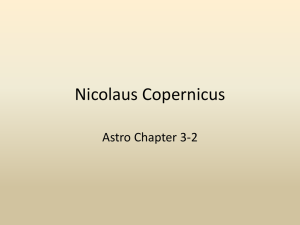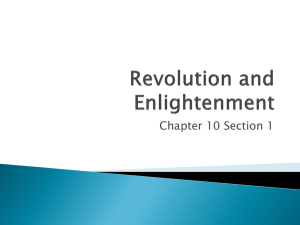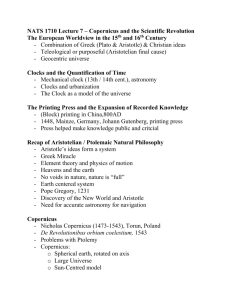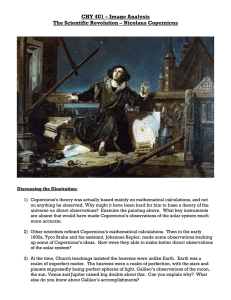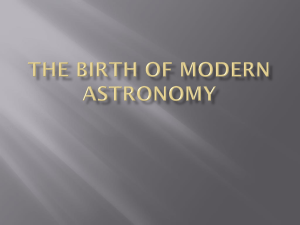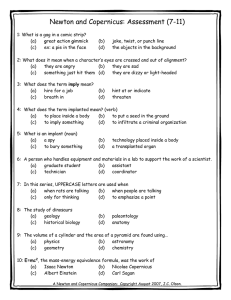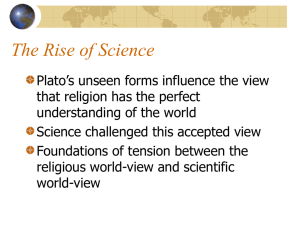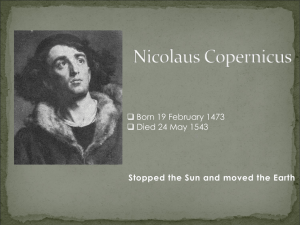Episode 13: Planetary paths-1
advertisement
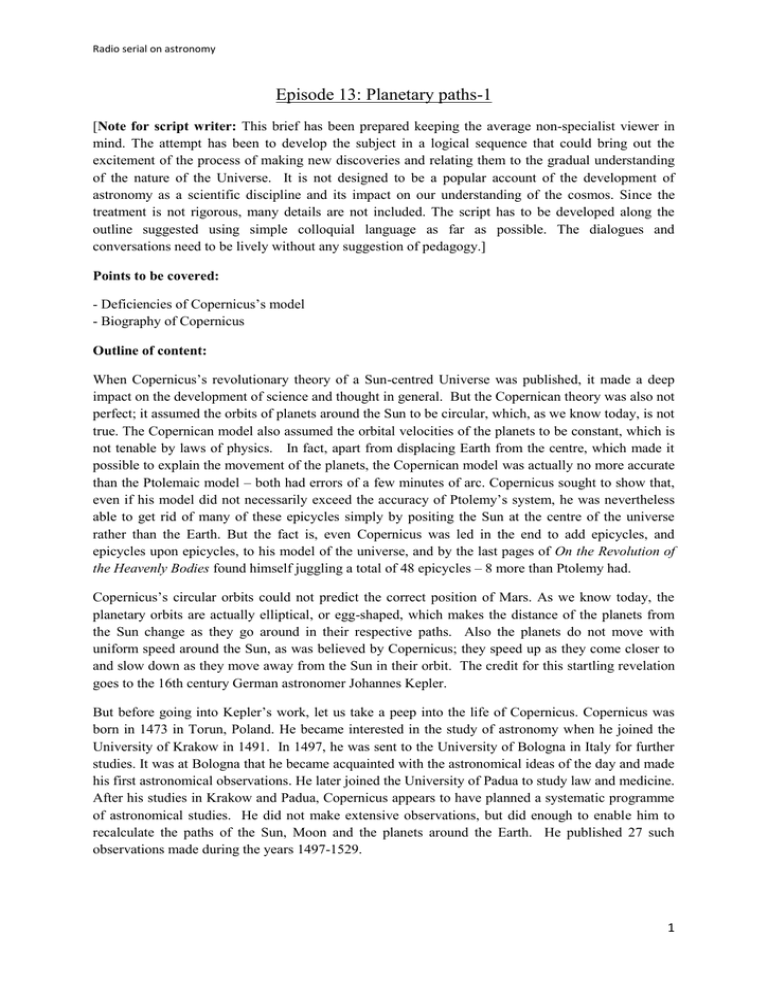
Radio serial on astronomy Episode 13: Planetary paths-1 [Note for script writer: This brief has been prepared keeping the average non-specialist viewer in mind. The attempt has been to develop the subject in a logical sequence that could bring out the excitement of the process of making new discoveries and relating them to the gradual understanding of the nature of the Universe. It is not designed to be a popular account of the development of astronomy as a scientific discipline and its impact on our understanding of the cosmos. Since the treatment is not rigorous, many details are not included. The script has to be developed along the outline suggested using simple colloquial language as far as possible. The dialogues and conversations need to be lively without any suggestion of pedagogy.] Points to be covered: - Deficiencies of Copernicus’s model - Biography of Copernicus Outline of content: When Copernicus’s revolutionary theory of a Sun-centred Universe was published, it made a deep impact on the development of science and thought in general. But the Copernican theory was also not perfect; it assumed the orbits of planets around the Sun to be circular, which, as we know today, is not true. The Copernican model also assumed the orbital velocities of the planets to be constant, which is not tenable by laws of physics. In fact, apart from displacing Earth from the centre, which made it possible to explain the movement of the planets, the Copernican model was actually no more accurate than the Ptolemaic model – both had errors of a few minutes of arc. Copernicus sought to show that, even if his model did not necessarily exceed the accuracy of Ptolemy’s system, he was nevertheless able to get rid of many of these epicycles simply by positing the Sun at the centre of the universe rather than the Earth. But the fact is, even Copernicus was led in the end to add epicycles, and epicycles upon epicycles, to his model of the universe, and by the last pages of On the Revolution of the Heavenly Bodies found himself juggling a total of 48 epicycles – 8 more than Ptolemy had. Copernicus’s circular orbits could not predict the correct position of Mars. As we know today, the planetary orbits are actually elliptical, or egg-shaped, which makes the distance of the planets from the Sun change as they go around in their respective paths. Also the planets do not move with uniform speed around the Sun, as was believed by Copernicus; they speed up as they come closer to and slow down as they move away from the Sun in their orbit. The credit for this startling revelation goes to the 16th century German astronomer Johannes Kepler. But before going into Kepler’s work, let us take a peep into the life of Copernicus. Copernicus was born in 1473 in Torun, Poland. He became interested in the study of astronomy when he joined the University of Krakow in 1491. In 1497, he was sent to the University of Bologna in Italy for further studies. It was at Bologna that he became acquainted with the astronomical ideas of the day and made his first astronomical observations. He later joined the University of Padua to study law and medicine. After his studies in Krakow and Padua, Copernicus appears to have planned a systematic programme of astronomical studies. He did not make extensive observations, but did enough to enable him to recalculate the paths of the Sun, Moon and the planets around the Earth. He published 27 such observations made during the years 1497-1529. 1 Radio serial on astronomy In 1500, when Copernicus became a professor of astronomy at the University of Rome, he taught the traditional Ptolemaic astronomy, but he was never fully convinced of the idea of an Earth-centred Universe. Once in 1502, while lecturing on the design of the Universe he said, “The Earth is the centre of the Universe; the Sun, Moon and the five planets revolve around our majestic Earth in a perfect circle. Beyond all these are the all-encompassing fixed stars. These are basic truths which are described by the great Claudius Ptolemy more than 1500 years ago and which are evident to the senses.” A bright-eyed young man stood up to ask a question. “Learned professor”, he spoke with a low voice, “did not the ancient Greek philosopher Pythagoras dispute this, saying that it is not the Earth but the Sun that is the centre of the Universe?” Copernicus was about to respond, as he had many times before, asserting the Ptolemaic ideas. But this time he hesitated to do that. He had so little faith in his usual answer that he dismissed the class and abruptly left the room. After three years of teaching something that he did not believe in, Copernicus made up his mind to resign and return to his home in Poland to devote himself to proving to his own satisfaction whether Ptolemy and the learned professors of his time were right or wrong. After his return to his hometown in Poland in 1506, Copernicus practised as a physician and also served the church. In addition, like a true scientist he began his own observations of the sky in his spare time. Nights would find him in the tower of his mountaintop home, observing the stars and planets, making notations about their positions and reading all available manuscripts of earlier astronomers. Although Copernicus had found the real clue to the motion of the planets by 1514, he was hesitant to make it public, afraid of being ridiculed and rejected by the Church, which had little regard for scientific ideas. Between 1510 and 1514, he prepared a brief, anonymous paper to summarise his new idea in which he put forward the suggestion that the apparent daily motion of the stars, the yearly motion of the Sun, and the apparently erratic behaviour of the planets resulted from the Earth’s daily rotation on its axis and yearly revolution around the Sun, which is stationary at the centre of the planetary system. Therefore, the Earth, Copernicus proclaimed, is the centre of not the Universe but only of the Moon’s orbit. Initially, for fear of ridicule, Copernicus privately circulated the paper among his friends, but it was left to his friends to go ahead and take up the responsibility of getting the work into print. A copy of Copernicus’s revolutionary work, titled On the Revolutions of the Celestial Spheres is believed to have been brought to the great astronomer at his bedside on the last day of his life, on 24 May 1543. He never actually read the printed book that changed for all times the worldview of the Universe by putting the Sun in its rightful place and giving a new perspective to our understanding of the Universe. 2

